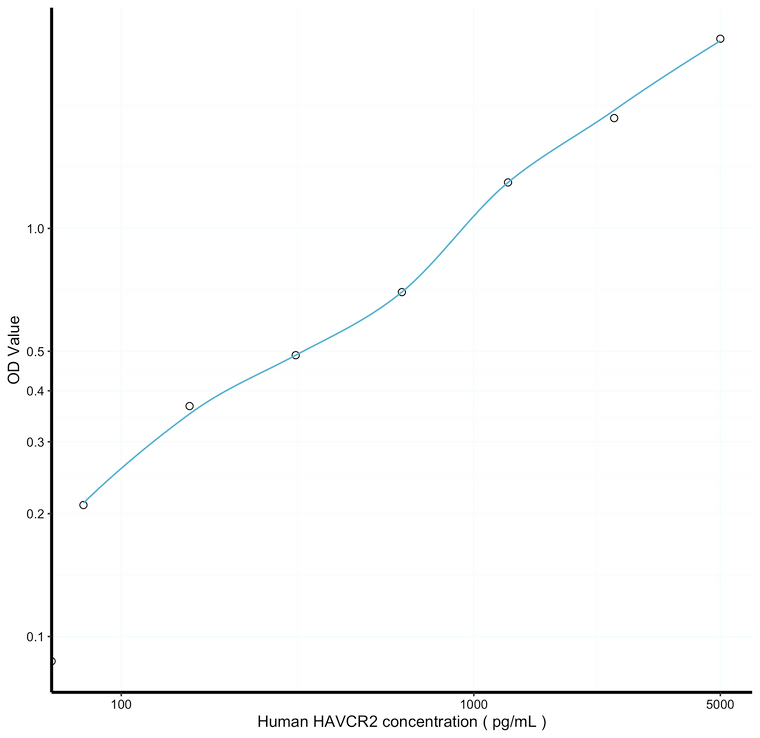| Applications: |
ELISA |
| Reactivity: |
Human |
| Note: |
STRICTLY FOR FURTHER SCIENTIFIC RESEARCH USE ONLY (RUO). MUST NOT TO BE USED IN DIAGNOSTIC OR THERAPEUTIC APPLICATIONS. |
| Sensitivity: |
36pg/mL |
| Detection Limit: |
78.1-5000pg/mL |
| Short Description: |
This HAVCR2 Sandwich ELISA Kit is an in-vitro enzyme-linked immunosorbent assay for the measurement of samples in human cell culture supernatant, serum and plasma (EDTA, citrate, heparin). |
| Storage Instruction: |
Store the unopened kit in the fridge at 2-8°C for up to 6 months. Once opened store individual kit contents according to components table provided with the kit. |
| Assay Time: |
4.5 hrs |
| Gene Symbol: |
HAVCR2 |
| Gene ID: |
84868 |
| Uniprot ID: |
HAVR2_HUMAN |
| Sample Type: |
tissue homogenates, cell lysates or other biological fluids. |
| Tissue Specificity | Expressed in T-helper type 1 (Th1) lymphocytes. Expressed on regulatory T (Treg) cells after TCR stimulation. Expressed in dendritic cells and natural killer (NK) cells. Expressed in epithelial tissues. Expression is increased on CD4+ and CD8+ T-cells in chronic hepatitis C virus (HCV) infection. In progressive HIV-1 infection, expression is up-regulated on HIV-1-specific CD8 T-cells. |
| Post Translational Modifications | O-glycosylated with core 1 or possibly core 8 glycans. Phosphorylated on tyrosine residues.modestly increased after TCR/CD28 stimulation. Can be phosphorylated in the cytoplasmatic domain by FYN. Phosphorylation at Tyr-265 is increased by stimulation with ligand LGALS9. |
| Function | Cell surface receptor implicated in modulating innate and adaptive immune responses. Generally accepted to have an inhibiting function. Reports on stimulating functions suggest that the activity may be influenced by the cellular context and/or the respective ligand. Regulates macrophage activation. Inhibits T-helper type 1 lymphocyte (Th1)-mediated auto- and alloimmune responses and promotes immunological tolerance. In CD8+ cells attenuates TCR-induced signaling, specifically by blocking NF-kappaB and NFAT promoter activities resulting in the loss of IL-2 secretion. The function may implicate its association with LCK proposed to impair phosphorylation of TCR subunits, and/or LGALS9-dependent recruitment of PTPRC to the immunological synapse. In contrast, shown to activate TCR-induced signaling in T-cells probably implicating ZAP70, LCP2, LCK and FYN. Expressed on Treg cells can inhibit Th17 cell responses. Receptor for LGALS9. Binding to LGALS9 is believed to result in suppression of T-cell responses.the resulting apoptosis of antigen-specific cells may implicate HAVCR2 phosphorylation and disruption of its association with BAG6. Binding to LGALS9 is proposed to be involved in innate immune response to intracellular pathogens. Expressed on Th1 cells interacts with LGALS9 expressed on Mycobacterium tuberculosis-infected macrophages to stimulate antibactericidal activity including IL-1 beta secretion and to restrict intracellular bacterial growth. However, the function as receptor for LGALS9 has been challenged. Also reported to enhance CD8+ T-cell responses to an acute infection such as by Listeria monocytogenes. Receptor for phosphatidylserine (PtSer).PtSer-binding is calcium-dependent. May recognize PtSer on apoptotic cells leading to their phagocytosis. Mediates the engulfment of apoptotic cells by dendritic cells. Expressed on T-cells, promotes conjugation but not engulfment of apoptotic cells. Expressed on dendritic cells (DCs) positively regulates innate immune response and in synergy with Toll-like receptors promotes secretion of TNF-alpha. In tumor-imfiltrating DCs suppresses nucleic acid-mediated innate immune repsonse by interaction with HMGB1 and interfering with nucleic acid-sensing and trafficking of nucleid acids to endosomes. Expressed on natural killer (NK) cells acts as a coreceptor to enhance IFN-gamma production in response to LGALS9. In contrast, shown to suppress NK cell-mediated cytotoxicity. Negatively regulates NK cell function in LPS-induced endotoxic shock. |
| Protein Name | Hepatitis A Virus Cellular Receptor 2Havcr-2T-Cell Immunoglobulin And Mucin Domain-Containing Protein 3Timd-3T-Cell Immunoglobulin Mucin Receptor 3Tim-3T-Cell Membrane Protein 3Cd Antigen Cd366 |
| Database Links | Reactome: R-HSA-451927 |
| Cellular Localisation | MembraneSingle-Pass Type I Membrane ProteinCell JunctionCell MembraneLocalizes To The Immunological Synapse Between Cd8+ T-Cells And Target Cells |
| Alternative ELISA Names | Hepatitis A Virus Cellular Receptor 2 ELISA kitHavcr-2 ELISA kitT-Cell Immunoglobulin And Mucin Domain-Containing Protein 3 ELISA kitTimd-3 ELISA kitT-Cell Immunoglobulin Mucin Receptor 3 ELISA kitTim-3 ELISA kitT-Cell Membrane Protein 3 ELISA kitCd Antigen Cd366 ELISA kitHAVCR2 ELISA kitTIM3 ELISA kitTIMD3 ELISA kit |
| output | |
Information sourced from Uniprot.org
12 months for antibodies. 6 months for ELISA Kits. Please see website T&Cs for further guidance






